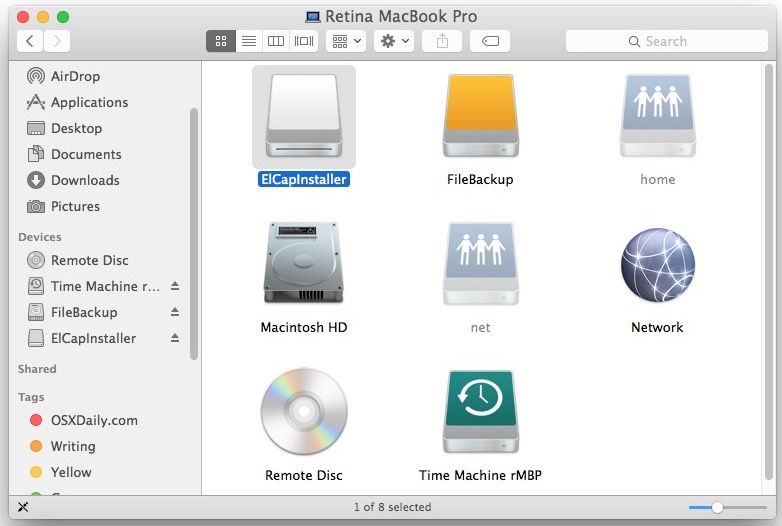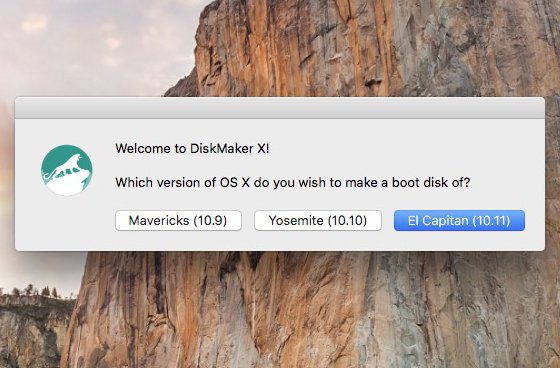- Download Mac OS EL Capitan 10.11 latest version; How to create Bootable USB for Mac OS El Capitan on Windows; How to Install Mac OS X El Capitan on Virtualbox on Windows; Steps to Install Mac OS X El Capitan on VMware on PC. Before going to start creating a new Virtual machine for Mac OS X El Capitan you need to install unlocker for VMware.
- If you wanna create bootable USB flash drive for Mac OS X El Capitan on Windows PC. You need a TransMac Software. That’s not a problem if you use a computer that supports legacy or UEFI. Just you need TransMac and El Capitan dmg file. Siddharth choubisa September 20, 2016 at 3:43 PM.
Catalina 32 bit. These advanced steps are primarily for system administrators and people who are familiar with the command line. You don't need a bootable installer to upgrade macOS or reinstall macOS, but it can be useful when you want to install it on multiple computers without having to download the installer each time.
What you need to create a bootable installer
We've created El Capitan USB stick from both Yosemite and El Capitan, but your experience with other versions may vary. An 8GB or larger USB flash drive or an 8GB or larger partition on some other. This downloads as a disk image named InstallMacOSX.dmg. On a Mac that is compatible with El Capitan, open the disk image and run the installer within, named InstallMacOSX.pkg. It installs an app named Install OS X El Capitan into your Applications folder. You will create the bootable installer from this app, not from the disk image or.pkg installer. In this tutorial and video walkthrough, I’ll show you how to create a bootable USB drive for OS X El Capitan in just a few easy steps Note: your USB flash drive must be at least 8GB in size. Ensure that there’s nothing on the drive that you wish to keep, as this process will completely erase the drive including any volumes.

- A USB flash drive or other secondary volume, formatted as Mac OS Extended, with at least 12 GB of available storage
- A downloaded installer for macOS Big Sur, Catalina, Mojave, High Sierra or El Capitan
Download macOS
- Download: macOS Big Sur, macOS Catalina, macOS Mojave or macOS High Sierra
These will be downloaded to your Applications folder as an app called Install macOS [version name]. If the installer opens after download, quit it without continuing the installation. To get the correct installer, download from a Mac that is using macOS Sierra 10.12.5 or later, or El Capitan 10.11.6. For enterprise administrators, please download from Apple, not a locally hosted software update server. - Download: OS X El Capitan
This will be downloaded as a disk image called InstallMacOSX.dmg. On a Mac that is compatible with El Capitan, open the disk image and run the installer within, which has the name InstallMacOSX.pkg. It installs an app named Install OS X El Capitan into your Applications folder. You will create the bootable installer from this app, not from the disk image or .pkg installer.
Use the 'createinstallmedia' command in Terminal
How To Make An El Capitan Bootable Usb On Windows
Select the type of disk being used. Note that if you’re using a 8GB (or larger) USB thumb drive, it will be completely erased. DiskMaker will erase any complete volume that you signify, so if you wish to make a disk that can install Yosemite, El Capitan, and Sierra, consider using Disk Utility (found in the Applications/Utilities folder) to partition the drive into three separate volumes. How To: Create a Bootable Install USB Drive of Mac OS X 10.10 Yosemite How To: Change OS X’s Annoying Default Settings Using Terminal How To: Dual Boot Mac OS X 10.11 El Capitan & 10.10 Yosemite How To: Create a Bootable Install USB Drive of Mac OS X 10.11 El Capitan.
Create Windows 10 Bootable Usb
- Connect the USB flash drive or other volume that you're using for the bootable installer.
- Open Terminal, which is in the Utilities folder of your Applications folder.
- Type or paste one of the following commands in Terminal. These assume that the installer is in your Applications folder and MyVolume is the name of the USB flash drive or other volume you're using. If it has a different name, replace
MyVolumein these commands with the name of your volume.

Big Sur:*
Catalina:*
Mojave:*
High Sierra:*
Create El Capitan Bootable Usb From Dmg
El Capitan:
* If your Mac is using macOS Sierra or earlier, include the --applicationpath argument and installer path, similar to the way this was done in the command for El Capitan.
After typing the command:
Create Bootable Linux Flash Drive
- Press Return to enter the command.
- When prompted, type your administrator password and press Return again. Terminal doesn't show any characters as you type your password.
- When prompted, type
Yto confirm that you want to erase the volume, then press Return. Terminal displays the progress as the volume is being erased. - After the volume has been erased, you may see an alert stating that Terminal would like to access files on a removable volume. Click OK to allow the copy to proceed.
- When Terminal says it's finished, the volume will have the same name as the installer you downloaded, such as Install macOS Big Sur. You can now quit Terminal and eject the volume.
Use the bootable installer
Determine whether you're using a Mac with Apple silicon, then follow the appropriate steps:
Apple silicon
- Plug the bootable installer into a Mac that is connected to the Internet and compatible with the version of macOS you're installing.
- Turn on your Mac and continue to hold the power button until you see the startup options window, which shows your bootable volumes and a gear icon labelled Options.
- Select the volume containing the bootable installer, then click Continue.
- When the macOS installer opens, follow the onscreen instructions.
Intel processor
- Plug the bootable installer into a Mac that is connected to the Internet and compatible with the version of macOS you're installing.
- Press and hold the Option (Alt) ⌥ key immediately after turning on or restarting your Mac.
- Release the Option key when you see a dark screen displaying your bootable volumes.
- Select the volume containing the bootable installer. Then click the up arrow or press Return.
If you can't start up from the bootable installer, make sure the External Boot setting in Startup Security Utility has been set to allow booting from external media. - Choose your language, if prompted.
- Select Install macOS (or Install OS X) from the Utilities window, then click Continue and follow the onscreen instructions.
Learn more
For more information about the createinstallmedia command and the arguments that you can use with it, make sure the macOS installer is in your Applications folder, then enter the appropriate path in Terminal:


- Big Sur: /Applications/Install macOS Big Sur.app/Contents/Resources/createinstallmedia
- Catalina: /Applications/Install macOS Catalina.app/Contents/Resources/createinstallmedia
- Mojave: /Applications/Install macOS Mojave.app/Contents/Resources/createinstallmedia
- High Sierra: /Applications/Install macOS High Sierra.app/Contents/Resources/createinstallmedia
- El Capitan: /Applications/Install OS X El Capitan.app/Contents/Resources/createinstallmedia
El Capitan Create Bootable Usb Windows
A bootable installer doesn't download macOS from the Internet, but it does require an Internet connection to get firmware and other information specific to the Mac model.
My brother-in-law brought me a Mac to fix, it looks like the OS was wiped or corrupted and the recovery partition was useless. It had El Capitan, but I've not been able to create a usable bootable USB using the DMG from Apple's site. I've tried with my M1 MacBook, I've tried using TransMac on Windows, but that didn't seem to help (wasn't bootable). I'm at the point where I'm thinking I need to tell him I'll have to purchase the physical media because the recovery mode won't even let me download the OS, I assume because you need an iCloud account with the OS tied to it. I can't believe how needlessly complicated this is (or I'm making it?). /whine